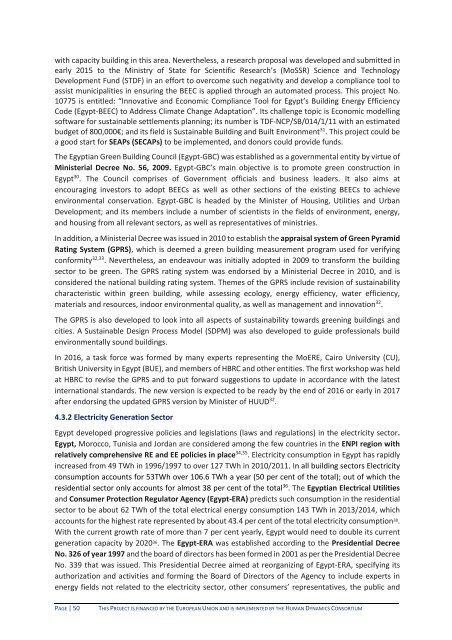180917_CES-MED_National_Report_Egypt_FINAL2rev
You also want an ePaper? Increase the reach of your titles
YUMPU automatically turns print PDFs into web optimized ePapers that Google loves.
with capacity building in this area. Nevertheless, a research proposal was developed and submitted in<br />
early 2015 to the Ministry of State for Scientific Research’s (MoSSR) Science and Technology<br />
Development Fund (STDF) in an effort to overcome such negativity and develop a compliance tool to<br />
assist municipalities in ensuring the BEEC is applied through an automated process. This project No.<br />
10775 is entitled: “Innovative and Economic Compliance Tool for <strong>Egypt</strong>’s Building Energy Efficiency<br />
Code (<strong>Egypt</strong>-BEEC) to Address Climate Change Adaptation”. Its challenge topic is Economic modelling<br />
software for sustainable settlements planning; its number is TDF-NCP/SB/014/1/11 with an estimated<br />
budget of 800,000€; and its field is Sustainable Building and Built Environment 31 . This project could be<br />
a good start for SEAPs (SECAPs) to be implemented, and donors could provide funds.<br />
The <strong>Egypt</strong>ian Green Building Council (<strong>Egypt</strong>-GBC) was established as a governmental entity by virtue of<br />
Ministerial Decree No. 56, 2009. <strong>Egypt</strong>-GBC’s main objective is to promote green construction in<br />
<strong>Egypt</strong> 30 . The Council comprises of Government officials and business leaders. It also aims at<br />
encouraging investors to adopt BEECs as well as other sections of the existing BEECs to achieve<br />
environmental conservation. <strong>Egypt</strong>-GBC is headed by the Minister of Housing, Utilities and Urban<br />
Development; and its members include a number of scientists in the fields of environment, energy,<br />
and housing from all relevant sectors, as well as representatives of ministries.<br />
In addition, a Ministerial Decree was issued in 2010 to establish the appraisal system of Green Pyramid<br />
Rating System (GPRS), which is deemed a green building measurement program used for verifying<br />
conformity 32,33 . Nevertheless, an endeavour was initially adopted in 2009 to transform the building<br />
sector to be green. The GPRS rating system was endorsed by a Ministerial Decree in 2010, and is<br />
considered the national building rating system. Themes of the GPRS include revision of sustainability<br />
characteristic within green building, while assessing ecology, energy efficiency, water efficiency,<br />
materials and resources, indoor environmental quality, as well as management and innovation 32 .<br />
The GPRS is also developed to look into all aspects of sustainability towards greening buildings and<br />
cities. A Sustainable Design Process Model (SDPM) was also developed to guide professionals build<br />
environmentally sound buildings.<br />
In 2016, a task force was formed by many experts representing the MoERE, Cairo University (CU),<br />
British University in <strong>Egypt</strong> (BUE), and members of HBRC and other entities. The first workshop was held<br />
at HBRC to revise the GPRS and to put forward suggestions to update in accordance with the latest<br />
international standards. The new version is expected to be ready by the end of 2016 or early in 2017<br />
after endorsing the updated GPRS version by Minister of HUUD 32 .<br />
4.3.2 Electricity Generation Sector<br />
<strong>Egypt</strong> developed progressive policies and legislations (laws and regulations) in the electricity sector.<br />
<strong>Egypt</strong>, Morocco, Tunisia and Jordan are considered among the few countries in the ENPI region with<br />
relatively comprehensive RE and EE policies in place 34,35 . Electricity consumption in <strong>Egypt</strong> has rapidly<br />
increased from 49 TWh in 1996/1997 to over 127 TWh in 2010/2011. In all building sectors Electricity<br />
consumption accounts for 53TWh over 106.6 TWh a year (50 per cent of the total); out of which the<br />
residential sector only accounts for almost 38 per cent of the total 36 . The <strong>Egypt</strong>ian Electrical Utilities<br />
and Consumer Protection Regulator Agency (<strong>Egypt</strong>-ERA) predicts such consumption in the residential<br />
sector to be about 62 TWh of the total electrical energy consumption 143 TWh in 2013/2014, which<br />
accounts for the highest rate represented by about 43.4 per cent of the total electricity consumption 38 .<br />
With the current growth rate of more than 7 per cent yearly, <strong>Egypt</strong> would need to double its current<br />
generation capacity by 2020 36 . The <strong>Egypt</strong>-ERA was established according to the Presidential Decree<br />
No. 326 of year 1997 and the board of directors has been formed in 2001 as per the Presidential Decree<br />
No. 339 that was issued. This Presidential Decree aimed at reorganizing of <strong>Egypt</strong>-ERA, specifying its<br />
authorization and activities and forming the Board of Directors of the Agency to include experts in<br />
energy fields not related to the electricity sector, other consumers’ representatives, the public and<br />
PAGE | 50<br />
THIS PROJECT IS FINANCED BY THE EUROPEAN UNION AND IS IMPLEMENTED BY THE HUMAN DYNAMICS CONSORTIUM

















